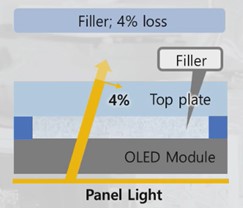[GLOBAL TECH KOREA 2021] Samsung Display ‘Display Innovation: Form Factor, Energy Saving, Color’

At ‘GLOBAL TECH KOREA 2021’ held in September 2021, Changhee Lee, Head of Samsung Display’s Next Generation Research Department (Vice President) delivered a keynote speech on the topic of ‘Display Innovation: Form Factor, Energy Conservation, and Color’.
For the first time in the form factor sector, Vice President Lee said, “The screen-to-body ratio, which was only 50% in the early days, has recently reached over 85%” and “We are in the process of introducing UPC (Under Panel Camera) technology to use full screens in various product groups he said. UPC technology can be applied to laptops as well as smartphones, and he said that advanced technology is needed to gradually increase the resolution of the camera and create the same luminance and color as the surrounding screen.
Vice President Lee said, “In 2010, flat screens evolved into various form factors such as foldables and rollables, and most inconveniences in durability, convenience, and usability disappeared”. In addition, Vice President Lee said, “Active devices such as OLEDs and transistors are placed on a neutral plane and designed to be protected by multiple layers, and a foldable display can be made with UTG with reduced thickness and increased durability”. Vice President Lee continued, “If not only folding but also rollable are made, the volume will be much smaller, and the technology is high enough to be commercialized now”, He said, “Materials with excellent properties that can be repeatedly deformed and restored will be developed and will be employed in various products through technology that can make them mechanically strong”. He said, “Materials with excellent properties that can be repeatedly deformed and restored will be developed and will be employed in various products through technology that can make them mechanically strong.”

In terms of energy saving, Vice President Lee explained that Samsung Display’s ‘Eco Square OLED’ is “a technology that reduces power consumption by removing the polarizer” and “We are further developing this technology to further reduce power consumption” He said. In addition, in terms of software, he said, “When ‘Windows 11 Dark Mode’, which can use OLED display more efficiently than before, is released, it is possible to reduce OLED light-emitting power consumption by more than 25%”.
In the color gamut sector, Vice President Lee said, “The higher the saturation and the wider the color gamut, the brighter the human body perceives it.”, and he said, “We are developing a new index called XCR (experienced color range) and evaluating the picture quality of the display through it”. In addition, he said, “We are developing a display with lower power consumption and higher saturation using quantum dots” and “It has already been applied to LCD and applied to Samsung Electronics’ QLED, and QD-OLED products will be released soon, and QD-LED will also be developed” he announced.
Lastly, Vice President Lee said, “Various sensors are being combined and applied to displays, and they have developed innovatively in various form factors, sizes, picture quality and the application changes have also expanded. Companies in the sector must work together to achieve technological innovation” he emphasized.





